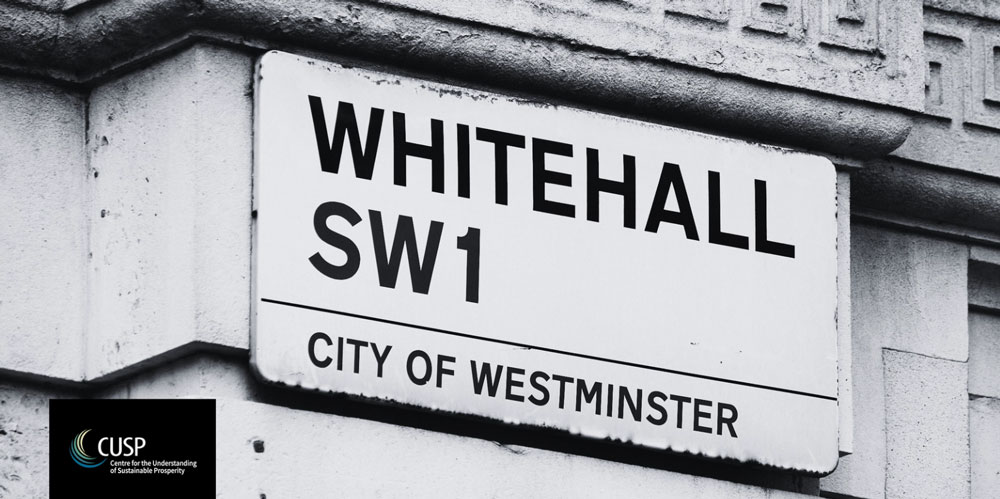Whitehall’s new delivery plans aren’t strong enough on the environment
Whitehall’s delivery plans need strengthening, CUSP researcher Richard Douglas writes in this blog, summarising the findings of a recent APPG briefing on the UK Government’s new Outcome Delivery Plans. (This blog first appeared on the Inside track website.)
Blog by Richard McNeill Douglas

How well is the government delivering on its environmental pledges? Wouldn’t it be useful if it brought together all of its major commitments, setting out what actions it was taking to achieve them, the resources it was using and the performance metrics that illustrated progress? This would enable MPs and the public to see where the UK was on track and where it was clearly falling behind.
The new plans replace previous attempts to track delivery
In July last year the government went some way towards making this a reality when 16 departments launched new outcome delivery plans (ODPs). These set out the main outcomes each department wants to achieve (including, but not confined to, environmental issues), together with their policies, resources and performance indicators.
This isn’t the first time the government has done this. Before ODPs there were Theresa May’s single departmental plans. Before them came David Cameron’s departmental business plans. And, before that, we had Labour’s public service agreements. Each was abandoned as political fashions changed, before being reinvented by the next administration. None of these systems was perfect. Single departmental plans, for instance, came in for criticism from the Public Accounts Committee and Institute for Government for not doing enough to cast light on what the departments were really doing.
So, will ODPs do better? And will they offer a meaningful way to hold the government to account for its performance, especially on environmental and wellbeing agendas? A new briefing paper published by the All Party Parliamentary Group on Limits to Growth, chaired by Caroline Lucas MP, puts them to the test.
In recent months, the APPG has looked at research, produced by us at CUSP, as well as by UCL’s Institute for Global Prosperity, on how well designed performance indicator systems can help to improve the delivery of sustainable public policy. Drawing on this, as well as critiques of past government performance frameworks, this briefing identifies what’s good and bad in ODPs and makes recommendations.
There’s a new emphasis on public engagement
First, the good news. Environmental and wellbeing objectives are widely reflected in departmental programmes, with UK commitments to the Sustainable Development Goals (SDGs) threaded throughout. There is a new emphasis on public engagement to use “improved knowledge of what truly delivers outcomes for citizens” to drive policy improvement. And there is welcome recognition that “many policy challenges require cooperation across multiple departments”, resulting in 16 cross government priorities, not least the objective, shared by five departments, to “reduce UK greenhouse gas emissions to net zero by 2050”. Interdepartmental collaboration is obviously important in a technical sense, to get policy design right for multidimensional problems like climate change.
Politically, as well, it is important that responsibility for delivering on sustainability goals is rooted throughout Whitehall, not only in Defra which, according to a biting comment by the Public Accounts Committee last year, lacks the clout to lead the rest of government.
Growing GDP conflicts with other priorities
Now the not so good news. One point that leaps out from these ODPs is the uncritical priority they give to the pursuit of economic (GDP) growth. This isn’t confined to the Treasury or BEIS but spread across Whitehall. The Department for Education’s number one priority, for example, is to “Drive economic growth through improving the skills pipeline, levelling up productivity and supporting people to work.”
There is no hint of the profound concerns raised about pursuing GDP growth as a policy goal (Tim Jackson’s Post Growth provides a good summary). Crucially, there is no recognition of trade offs between objectives. BEIS has one priority to “Tackle climate change” and another to “Back long-term growth”. Each is treated like a separate deliverable, with no assessment of the degree to which achieving one might make the other harder to do, nor how such conflicts might be reconciled.
As for ODPs’ widespread references to environmental objectives, these fall short of a coherent vision. For example, Defra does not clearly set out how its objectives link with the government’s 25 year environment plan and its ten overarching priorities. Similarly, performance indicators within ODPs do not clearly map across to SDGs, and no indicators at all are displayed on the one central webpage where the government sets out its SDG commitments.
Another issue is that objectives and performance metrics are often framed too broadly to be effective. Take, for example, the housing and communities objective for “More, better quality, safer, greener and more affordable homes”. Eight performance indicators are presented as measuring progress against this, but only one (“Number of Energy Performance Certificates created”) relates to the ‘greener’ component. The ODP does not provide any guidance on the weighting given to this component, meaning it is unclear how its reporting will differentiate its performance in delivering ‘greener’ as distinct from ‘more’ homes.
Plans need to be more than good publicity
If they are not improved, the danger is that ODPs will fulfil the role of promotional material, whose purpose is to put departments in a good light by selectively highlighting policies and metrics that convey an impression of activity and progress, but which do not add up to a ‘warts and all’ picture of whether government objectives are likely to be delivered.
The APPG on Limits to Growth paper recognises that there are some promising features, not least the apparent commitment of the Treasury and the Cabinet Office to make a success of them. But, among the recommendations identified are three priorities for change:
- the Treasury should consult on a measure of sustainable wellbeing to replace GDP growth as one of its key performance measures;
- the Cabinet Office and Treasury should work towards ODPs which calculate the net effects of conflicting policies on different priorities, for instance they should reflect negative impacts of road building investment on air quality and climate change objectives;
- the Cabinet Office, working with Defra and BEIS, should develop an overall sustainability dashboard, pulling together all the government’s most important targets and commitments on environment and wellbeing policy agendas.
These are early days in the life of the newest iteration of Whitehall’s attempts to establish a public facing performance management system. There is certainly no need to scrap them and start all over yet again. But there is plenty of scope for improvement.
Links
- Targeting Sustainability—A review of the UK Government’s outcome delivery plans | The briefing paper can be accessed via the APPG website.



